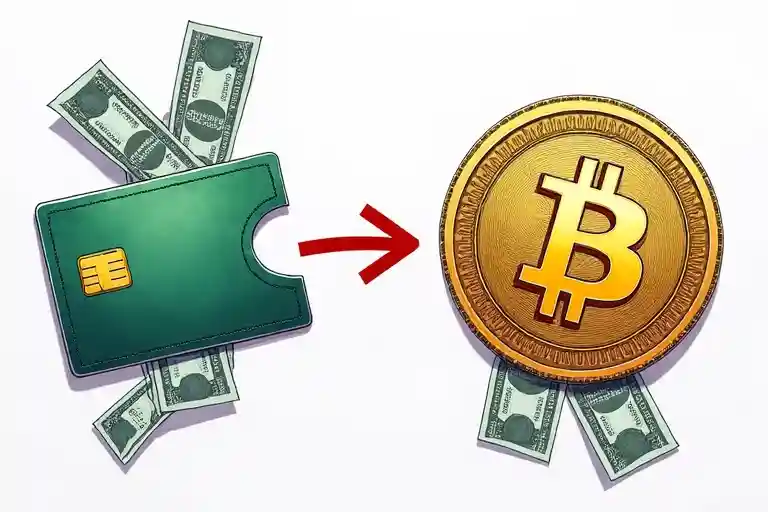Alright, let’s dive in! You’ve probably heard about Bitcoin, Ethereum, and all that jazz. Maybe you’ve even got a little bit from an airdrop or a crypto faucet. Now, the big question is, can you actually *use* it like, for everyday stuff? That’s where the idea of a crypto pay card comes in, and OMG, it’s a whole world! This isn’t just some boring finance talk; think of it like unlocking a new level in your money game. We’re going to break down what these cards are, how they work (no cap!), look at the different types like a Crypto Visa card, figure out if you can snag a free crypto debit card, and most importantly, whether using a crypto pay card is a good move for you as a teen. We’ll cover the awesome, the tricky, and the “should I even bother?” parts. I was pretty surprised by some of this stuff myself! We’ll even touch on things like Cryptopay and the sketchiness of “no KYC” cards. So, grab your notes app, ’cause this is the info you’ll want. Last updated: June 2025.
What Exactly IS a Crypto Pay Card? (And Why Should You Even Care?)
Okay, so picture your regular debit card from a bank. You use it to buy snacks, games, whatever. A crypto pay card is kinda similar, but with a super cool twist: it lets you spend your cryptocurrency in places that normally only take regular money (like dollars, euros, etc.). Wild, right? You’re not directly handing over Bitcoin to the cashier at Starbucks – that would be chaotic, LOL. Instead, when you swipe or tap your crypto pay card, the card company instantly converts the right amount of your crypto into traditional money to pay the store. It’s like having a tiny, super-fast money changer in your wallet!
Why should you care? Well, if you’re into crypto, or think you might be, these cards bridge the gap between the digital crypto world and the everyday spending world. It makes your crypto more *usable*. Imagine earning some crypto through a best crypto earning app and then using a card to shop for a brand new sport with it. That’s the dream for some! But hold up, it’s not all sunshine and Dogecoin. There are prices, policies, and (exceptional essential for teens) age restrictions and protection matters to think about. It’s no longer just about “wen Lambo?”; it’s about clever, secure spending. Think of it as a new device, and like any device, you need to recognize the way to use it nicely. We’ll get into the nitty-gritty, like how a whole lot you could absolutely make or spend, later on.
Best crypto pay card (How to Spot a Winner for Teens)
So, you’re thinking a crypto pay card sounds kinda cool. But how do you find the “best” one, especially when you’re a teen? It’s not like picking your favorite TikTok filter; there’s a bit more to it. The “best” card for an adult day-trader might be totally different from the best one for a student who’s just starting to explore crypto. For teens, priorities should be safety, low fees, ease of use, and STRONG parental involvement. Don’t just jump on the first one you see advertised by an influencer. Do your homework! Or, you know, read this guide. 😉
When looking for the best crypto pay card for a younger user, you need to consider factors like parental control features, clear explanations of how the crypto conversion works, and what happens if the value of your crypto suddenly drops (because, trust me, it can be a rollercoaster!). Some cards might offer flashy crypto rewards, but if the fees are sky-high, those rewards might not be worth it. It’s like getting a “free” pizza but then paying $20 for delivery – the math ain’t mathing!
Features to Look For in a crypto pay card
When you’re on the hunt for a crypto pay card, especially as a teen, there are some key things to keep an eye out for. First up: **Security**. This is HUGE. Make sure the card provider has strong security measures, like two-factor authentication (2FA) and ways to freeze your card if it gets lost. You wouldn’t want your hard-earned crypto to just vanish, right? Next, check out the **Supported Cryptocurrencies**. Does it support the crypto you have or are interested in? Some cards only work with a few major coins, while others offer a wider range. Don’t get a card that won’t let you use the crypto you actually own!
Then there may be Ease of Use. The app or website for coping with your card need to be user-friendly. If it looks like it became designed within the Stone Age or is first-rate difficult, that’s a pink flag. You want something that makes it easy to load crypto, test your balance, and notice your transactions. Also, inspect Parental Controls/Oversight if you’re beneath 18. Many platforms would require a determine or guardian to set up and control an account for a minor. This is without a doubt a GOOD element – it provides a layer of protection. And subsequently, Customer Support. If something is going wrong, you want that allows you to get assist effortlessly. Check if they have responsive customer support – nobody wants to be left on study when their cash is worried!
Understanding Fees (The Sneaky Costs!)
Okay, let’s talk about the not-so-fun part: fees. Almost every crypto pay card will have some kind of fees. It’s how these companies make money. Think of it like this: you know how some games have in-app purchases? Cards have fees. There can be **Transaction Fees** every time you buy something, or **ATM Withdrawal Fees** if you try to take cash out. Some also have **Foreign Transaction Fees** if you use the card in another country (maybe on that family vacay?).
But the big one to watch for is the **Crypto Conversion Fee** or **Spread**. This is the fee for actually turning your crypto into regular money when you make a purchase. It might be a percentage, or it might be a bit hidden in the exchange rate they give you. It’s super important to understand these because they can add up FAST. Imagine you think you’re paying $10 for something, but with fees, it’s actually $10.50. Doesn’t sound like much, but do that a bunch of times, and it’s a dent in your crypto stash! Always read the fine print – I know, I know, BORING, but so necessary. Some companies are more transparent about their fees than others. If understanding how much money can you actually spend is important, fee clarity is essential.

Free crypto debit card (Are They REALLY Free?)
You’ve probably seen ads: “Get your FREE crypto debit card today!” Sounds amazing, right? Who doesn’t love free stuff? But when it comes to financial products, “free” often comes with a little asterisk*. Is a free crypto debit card truly free, or is it like those mobile games that are “free to play” but then hit you with a million ways to spend real money? Let’s investigate, Sherlock style!
Often, when a company says their crypto pay card is “free,” they mean there’s no upfront fee to order the physical card, or maybe no monthly maintenance fee. That’s cool, but it doesn’t mean using the card is cost-free. They might make their money through slightly higher conversion fees when you spend, or withdrawal fees, or inactivity fees if you don’t use the card for a while. It’s like a magic trick – the cost is still there, just hidden somewhere else. This doesn’t mean “free” cards are bad, but you need to be a savvy consumer and look beyond the headline.
The Catch with “Free” Cards
So, what’s the catch with a supposedly free crypto debit card? Well, as we just said, the main “catch” is that “free” usually just refers to the absence of an issuance fee or a monthly fee. The card provider still needs to make money. They might do this through the spread (the difference between the crypto market price and the price they give you when you spend), transaction fees for certain types of purchases, or ATM withdrawal charges. Think about it: if they gave everything away for free and also paid for the plastic card and shipping, they’d go broke pretty fast!
Another thing to watch out for is minimum balance requirements or staking requirements. Some “free” cards might require you to hold a certain amount of their own specific cryptocurrency in your account to unlock the best benefits or avoid fees. This can be risky because if that crypto’s value drops, you lose money. It’s kinda like needing a VIP pass to get the “free” stuff – the pass itself might have a hidden cost or commitment. When exploring legit crypto earning app free options, you also need to be aware of how those earnings might be spent and what costs are involved if using a card.
Comparing “Free” Options
If you’re looking at different “free” crypto pay card options, you need to become a comparison ninja. Don’t just look at the word “FREE” in big shiny letters. Dig deeper! Create a little checklist for each card:
- Issuance Fee: Is the physical card actually free to get?
- Monthly Fee: Is there a recurring charge just to keep the account open?
- Transaction Fees (Domestic & International): What will it cost to actually buy something?
- Crypto Conversion Spread/Fee: This is often the BIG one. How much are they charging to change your crypto to spendable cash at the point of sale?
- ATM Withdrawal Fees: What if you need actual cash?
- Top-up Fees: Does it cost money to load crypto onto your card account?
- Required Staking/Minimum Balance: Do you have to lock up a bunch of their specific token to get the “free” benefits?
By comparing these, you’ll get a much clearer picture of which “free” crypto pay card is *actually* the most cost-effective for your needs. It’s like comparing stats on different characters in a video game – you want the one with the best overall value, not just the coolest-looking one.
Crypto Visa card (Your Questions Answered!)
You’ve definitely seen the Visa logo – it’s pretty much everywhere, from your parents’ wallets to online checkouts. So, what happens when crypto meets Visa? You get a Crypto Visa card! This is a super common type of crypto pay card. It means the card is issued by a crypto company (like Coinbase, Crypto.com, Binance, etc. – though availability and teen eligibility varies wildly and requires checking specific terms) but uses Visa’s global payment network. This is a big deal because it means you can use your Crypto Visa card wherever Visa is accepted – which is millions of places worldwide. Talk about convenience!
Having that Visa logo gives a sense of familiarity and widespread acceptance. It’s not some obscure card only a few niche online stores will take. You could (in theory, and depending on the specific card’s rules and your crypto balance) use it for your Spotify subscription, your online shopping, or even at your local pizza place. But remember, just because it has a Visa logo doesn’t mean it works *exactly* like a traditional Visa debit card from a bank. The crypto part adds a unique layer.
How do Crypto Visa cards work with crypto?
This is where the magic happens! When you use your Crypto Visa card, you’re not directly sending Bitcoin or Ethereum to the merchant. That would be too complicated and slow for most everyday transactions. Instead, here’s a simplified breakdown:
- You choose which crypto you want to “back” your card from your crypto account with the card issuer. Some cards let you pick a default, others make you specify.
- When you swipe, tap, or enter your card details online, the payment terminal talks to Visa.
- Visa talks to your crypto card issuer.
- The card issuer *instantly* sells just enough of your chosen crypto at the current market rate to cover the purchase amount in regular currency (like USD). This includes any fees they charge for the conversion.
- The merchant gets paid in their local currency, and the equivalent value in crypto (plus fees) is deducted from your account.
It all happens in seconds! It’s pretty slick technology. But that instant sale of crypto is a taxable event in many countries, which is something you (or your parents) need to be aware of. We’ll touch more on do I have to report crypto later, because, yeah, taxes are a thing even with cool tech.
Where can you use a Crypto Visa card?
This is one of the biggest advantages of a Crypto Visa card: you can use it pretty much anywhere that accepts regular Visa debit or credit cards. That means millions of merchants online and in physical stores, all around the world. Think about your favorite clothing store, your go-to spot for bubble tea, the platform where you buy your video games, or even for your streaming subscriptions. If they take Visa, they can likely take your Crypto Visa card.
This widespread acceptance is a huge plus because it makes your crypto much more liquid and spendable for everyday things, not just for trading or holding as an investment. However, always double-check if there are any specific merchant category restrictions with your particular card provider. Some might block transactions for certain things like gambling, for example. And, just because you *can* use it everywhere doesn’t always mean you *should* for every tiny purchase, especially if there are per-transaction fees. Use that big brain of yours!

Cryptopay (Is This the One for You?)
You might have seen the name “Cryptopay” pop up in your searches for a crypto pay card. Cryptopay is one of the services out there that offers crypto wallet services and, yes, crypto debit cards. They’ve been around for a while in the crypto space. Like other similar platforms, their goal is to make it easier for people to use their cryptocurrencies in the real world. They typically offer both physical and virtual cards, often on the Visa network.
Now, is Cryptopay (or any specific brand) “the one” for you as a teen? That’s a big question! It depends entirely on their current terms of service, age restrictions (VERY important!), the fees they charge, the cryptocurrencies they support, and how user-friendly their platform is for someone who might be newer to crypto. Remember, platforms change their rules and features, so what’s true today might be different tomorrow. This is where you (and your parents!) need to do some *current* research directly on their official website before even thinking about signing up. For example, you’d need to check their “How much does Cryptopay charge for cards?” details directly from them.
What Cryptopay offers
Generally, services like Cryptopay aim to provide a suite of tools. This often includes a crypto wallet where you can store various cryptocurrencies. Then, they offer a crypto pay card (often a Visa) that links to this wallet. This allows you to load cryptocurrency into your Cryptopay account and then spend it using the card. Some of the typical features you might find (and should verify on their official site!) include:
- Physical and Virtual Cards: Physical cards for in-store and ATM use, virtual cards for online purchases.
- Multiple Cryptocurrency Support: Ability to hold and spend various cryptos like Bitcoin, Ethereum, Litecoin, etc.
- App/Web Platform: For managing your account, loading funds, tracking spending, and security settings.
- Conversion Services: The core function of converting crypto to fiat (like USD, EUR, GBP) at the point of sale.
They might also offer features like buying and selling crypto directly within their platform. However, for a teen, the primary focus would be on the card and its usability, safety, and any parental controls or requirements for under-18s. Again, checking the current official info from Cryptopay is crucial as features and terms can change. For instance, understanding how they handle crypto earnings calculations and conversions is key.
Things to consider with Cryptopay
If you’re considering Cryptopay, or any specific crypto pay card provider, especially as a teen, here’s your mental checklist:
- Age Restrictions & Parental Consent: This is number one. Can a teen even legally use their service in your region? Will a parent or guardian need to open and manage the account? Don’t even *try* to fudge your age – it can lead to your account being frozen and funds lost. Seriously.
- Fees, Fees, Fees: Go through their fee schedule with a fine-tooth comb. What are the card issuance fees, monthly fees, transaction fees, ATM fees, and MOST importantly, the crypto conversion spread/fee? Compare these to other options.
- Supported Regions: Is their card available and fully functional in your country (e.g., “Can you get a crypto card in the UK?” or the US)?
- Security Features: What do they offer? 2FA? Card freezing options? Insurance for funds (rare for crypto balances themselves, but sometimes for fiat balances)?
- User Reviews & Reputation: What are other people saying about them? Look for recent reviews, keeping in mind that reviews can be biased. Check a few different sources. Forbes, for example, sometimes reviews financial products, or you might find discussions on reputable finance forums (though always be wary of shills!).
- Customer Support: If you have an issue, how easy is it to get help?
Think of it like choosing a new phone plan – you want the best features for the best price, from a company you can trust, and that actually works where you live! For example, if you are looking at ways to earn crypto through things like CoinbaseBest Crypto Faucets 2025, you’d want a card that supports the crypto you earn and doesn’t eat it all up in fees.
crypto debit card – no kyc (The Dangers & Why You Should (Probably) Avoid)
Okay, this one is SUPER important, so listen up! You might stumble across offers for a “crypto debit card – no kyc.” KYC stands for “Know Your Customer.” It’s a process that legitimate financial services (banks, crypto exchanges, card issuers) use to verify your identity. They’ll ask for things like your name, address, date of birth, and sometimes a photo ID. It’s a legal requirement in most places to prevent things like money laundering and to protect users.
So, a “no KYC” card sounds tempting, right? Less hassle, more privacy? WRONG. Especially for a teen, these are usually a massive red flag. 🚩🚩🚩 Why? Because services that don’t bother to know who their customers are can be really shady. They might have lax security, be involved in illegal activities, or could just disappear with your crypto one day. It’s like getting into a car with a stranger who says, “Don’t worry about a seatbelt, it’s cooler this way!” – big yikes!
What is KYC anyway?
KYC, or “Know Your Customer,” is a set of rules and processes that financial institutions and many other types of companies use to verify the identity of their clients. Think of it like showing your ID when you go to a movie that’s rated R, but for financial stuff. They’ll usually ask for your full name, date of birth, residential address, and often a government-issued ID like a driver’s license or passport. For teens, this process almost always involves a parent or legal guardian who is the primary account holder.
Why do companies do this? It’s not just to be nosy! KYC helps prevent identity theft, financial fraud, money laundering, and terrorist financing. It’s a legal and regulatory requirement in most countries. So, when a legitimate crypto pay card issuer asks for KYC documents, they’re following the law and trying to keep their platform secure. It might seem like a bit of a pain, but it’s actually a sign that the company is trying to operate responsibly.
Risks of No-KYC cards for teens
For teenagers, getting involved with a “crypto debit card – no kyc” service is a REALLY bad idea. Here’s why:
- High Scam Potential: Platforms offering no-KYC services are often less regulated, or completely unregulated. This makes them ripe for scams. They could simply disappear with your funds, and you’d have little to no recourse. It’s like giving your money to someone in a dark alley – sketchy!
- Security Risks: If they’re not verifying users, their overall security standards might be super low. Your data and your crypto could be at much higher risk of being hacked.
- Legal Trouble (for you or your parents): Depending on your region, using unverified financial services could have legal implications. Plus, if the platform is found to be involved in illicit activities, your funds could be frozen or seized as part_of an investigation. Not a good look.
- Lack of Support: If something goes wrong, who are you going to call? Shady, anonymous platforms usually have terrible (or non-existent) customer support.
- Unexpected Account Closure: These platforms can change their rules or get shut down by authorities without warning. One day your card works, the next day your account is gone. Poof!
Seriously, the allure of “anonymity” with a no-KYC crypto pay card is NOT worth these risks, especially when you’re young and still learning about financial responsibility. Stick with reputable platforms that follow the rules – it’s for your own protection. If you’re looking into airdrops to earn free crypto for teens, you want a safe place to potentially use those earnings, not a risky card.
Super Important Safety Tips for Your Crypto Pay Card
Alright, if you *do* decide (with your parents’ full approval and help!) to explore the world of crypto pay cards, safety has to be your number one priority. This isn’t like losing a couple of bucks from your allowance; crypto can be valuable, and you need to protect it like a digital dragon guarding its treasure hoard! Think of these tips as your cheat codes for staying safe in the crypto spending game.
The crypto world can be awesome, but it also has its wild west moments. Scammers are always coming up with new tricks, and because crypto is digital, sometimes it feels less “real” than cash, making it easier to make mistakes. But don’t let that scare you off entirely – just be smart! Being aware of the risks and taking precautions is key. It’s like knowing not to click on sketchy links in emails – basic internet safety, but with a crypto twist.
Parental Guidance is Key!
This is non-negotiable, especially if you’re under 18. Your parents or legal guardians *must* be involved. Why?
- Age Restrictions: Most legit financial platforms, including those offering a crypto pay card, require users to be 18 or older. If they allow younger users, it’s almost always through a custodial account opened and managed by a parent. Trying to sign up with false info is a recipe for disaster.
- Understanding the Risks: Crypto is volatile (prices go up and down like crazy!) and complex. Your parents can help you understand the financial risks involved. They’ve got more experience with money matters.
- Security Oversight: They can help you set up strong passwords, enable 2FA, and understand security best practices. Two heads are better than one when it comes to keeping your crypto safe.
- Financial Responsibility: They can guide you on responsible spending habits. A crypto card isn’t free money; it’s linked to assets that can lose value.
- Taxes: Yep, spending crypto can have tax implications. Your parents will need to be aware of this to handle things correctly. Knowing what is crypto income and how it’s treated is crucial.
Think of your parents as your experienced co-pilots on this crypto journey. They’re there to help you navigate safely. If a platform encourages you to sign up without parental knowledge if you’re underage, that’s a HUGE red flag – run away (digitally speaking)!
Protecting Your Crypto & Personal Info
Protecting your digital goodies – your crypto and your personal information – is just as important as locking your front door. Here’s the lowdown:
- Strong, Unique Passwords: Don’t use “password123” or your dog’s name for your crypto accounts. Use a password manager to create and store super strong, unique passwords for every site.
- Two-Factor Authentication (2FA): ALWAYS enable 2FA (like Google Authenticator or a YubiKey) whenever it’s offered. It’s an extra layer of security that makes it much harder for hackers to get in, even if they have your password.
- Beware of Phishing: Scammers will send fake emails or texts pretending to be from your card provider, trying to get your login details. NEVER click on suspicious links or give out your private keys or passwords. Always go directly to the official website by typing the URL yourself.
- Secure Your Devices: Keep your phone and computer updated with the latest security patches. Use antivirus software. Don’t download sketchy apps.
- Private Keys are PRIVATE: If you’re managing crypto in a non-custodial wallet (where you control the keys), NEVER share your private keys or seed phrase with anyone. Seriously, anyone. They are the keys to your crypto kingdom.
- Be Careful on Public Wi-Fi: Avoid accessing sensitive financial accounts or making transactions on unsecured public Wi-Fi networks. Hackers can snoop on these.
- Start Small: If you’re new to using a crypto pay card, don’t load up your entire crypto savings onto it. Start with a small amount you’re willing to experiment with until you get comfortable with how it works.
Being your own security chief sounds like a lot, but these habits will protect you not just in crypto, but all over the online world. It’s like that TikTok trend, “Tell me you’re security-conscious without telling me you’re security-conscious” – these actions speak louder than words!
Real Talk: Should a Teenager Get a Crypto Pay Card?
Okay, we’ve covered a LOT about what a crypto pay card is, the different types, the potential pitfalls, and how to stay safe. Now for the million-dollar question (or maybe the 0.001 Bitcoin question?): should YOU, as a teenager, actually get one? The answer is… it’s complicated! There’s no simple “yes” or “no” because it depends on your individual situation, your maturity level, your understanding of crypto, and (say it with me now) your parents’ involvement and approval.
A crypto pay card can be a cool tool to learn about managing digital assets and bridging the gap between crypto and everyday spending. It can feel empowering. But it also comes with responsibilities and risks that are different from just using a regular debit card linked to a bank account. The value of crypto can swing wildly – what buys a pizza today might only buy a slice tomorrow, or vice versa! That’s a lot to wrap your head around.
Pros and Cons for Your Age
Let’s break it down with a good old-fashioned pros and cons list, specifically for teens thinking about a crypto pay card:
Potential Pros:
- Learning Opportunity: It’s a hands-on way to learn about crypto transactions, fees, and managing digital assets. Kinda like a real-world finance class, but way cooler.
- Convenience (if you have crypto): If you’re already earning or receiving crypto (e.g., from crypto airdrops or safe online tasks), it can make that crypto easier to spend without first converting it through a separate exchange and then sending it to a bank.
- Feeling “Future-Forward”: Let’s be real, using crypto can feel pretty cutting-edge and tech-savvy. It’s like you’re living in 2077.
- Potential Rewards: Some cards offer crypto cashback or other rewards, which can be appealing (but always weigh these against the fees!).
Potential Cons (and these are BIG ones for teens):
- Volatility Risk: The value of your crypto can drop, meaning the money on your card could be worth less than when you loaded it. This is a huge risk if you’re relying on that money.
- Complexity: Understanding crypto, fees, conversions, and security can be overwhelming. It’s not as simple as a regular debit card.
- Security Risks: Crypto is a target for hackers and scammers. Protecting your account and card requires diligence.
- Fees, Fees, Fees: As mentioned, conversion fees, transaction fees, ATM fees – they can eat into your crypto balance quickly if you’re not careful.
- Impulse Spending: The “easy spend” nature might lead to spending crypto you intended to hold or save. It’s easy to tap and go!
- Age Restrictions & Parental Burden: Most legit options require significant parental involvement and oversight, which might not be ideal for every family.
- Tax Implications: Spending crypto is often a taxable event. This adds a layer of complexity that most teens (and many adults!) aren’t prepared for.
So, weigh these carefully! Is the “cool factor” worth the potential headaches and risks? For some, with the right guidance, maybe. For many others, sticking to traditional payment methods while learning about crypto separately might be a better bet for now.
Alternatives to consider
If a crypto pay card seems a bit much right now (and that’s totally okay!), there are other ways to engage with finance and digital money that might be more teen-appropriate:
- Traditional Teen Debit Cards (Bank-issued): Many banks offer debit cards for teens, often with parental controls and no crypto volatility risk. These are great for learning basic budgeting and spending.
- Focus on Earning & Saving Fiat: Before diving into spending crypto, focus on learning to earn and save regular money. There are tons of apps for earning that pay in cash, or you could explore traditional teen jobs.
- Educational Crypto Accounts (Look & Learn): Some platforms allow you to create an account just to learn about crypto, watch market movements, or use “paper trading” (practice trading with fake money) without risking real assets.
- Cash App / Venmo (with parental oversight): These are popular for P2P payments and some now offer limited crypto exposure, but again, parental involvement and understanding the terms for minors is crucial.
- Learning Resources: Instead of getting a card, spend time learning about blockchain technology, how different cryptos work, and financial literacy in general. Knowledge is power! Check out “.edu” websites for unbiased financial education.
Remember, there’s no rush to jump into every new financial tech. Understanding the basics of money management with less volatile assets is a super valuable skill that will serve you well, no matter what the future of money looks like. If you are keen on crypto, perhaps start by exploring lists of crypto faucets to earn tiny amounts for free and learn that way, without the pressure of a spending card.
Here’s a quick comparison table to help you think about it:
| Feature | Crypto Pay Card (for Teens) | Traditional Teen Debit Card |
|---|---|---|
| Primary Funding | Cryptocurrency (Bitcoin, ETH, etc.) | Fiat Currency (USD, EUR, etc.) |
| Volatility Risk | High (crypto value can change rapidly) | Very Low (linked to stable currency) |
| Complexity | High (conversions, crypto security, fees) | Low (straightforward spending) |
| Parental Involvement | Essential (often mandatory for under 18s) | High (usually required, good controls) |
| Learning Curve | Steep (understanding crypto + card use) | Moderate (basic money management) |
| Widespread Acceptance | Good (if Visa/Mastercard linked), but depends on having crypto | Excellent (standard banking network) |
| Primary Purpose | Spending crypto, learning about digital assets | Learning budgeting, everyday spending |
Conclusion
Phew! We’ve journeyed through the ins and outs of the crypto pay card, and hopefully, you’re feeling way more clued up. From understanding what they are, to spotting the best (and safest!) options for teens, to why “no KYC” is a big no-no, it’s clear that while these cards are innovative, they come with a unique set of rules and responsibilities. They can be a bridge between the crypto world and your everyday spending, but it’s a bridge that needs to be crossed carefully, especially when you’re young.
The key takeaways? Always prioritize safety, *always* involve your parents, understand the fees (because they’re real!), and be aware of the volatility of crypto. A crypto pay card isn’t just a cool gadget; it’s a financial tool. Remember that awesome feeling of earning your first crypto through an app or a game? Imagine that, but with the added layer of smart spending decisions.
What’s Next?
- Talk to Your Parents: Seriously, this is the first step. Share what you’ve learned.
- Do More Research: If you’re still interested, look into specific card providers *with your parents*. Check their latest terms and age requirements.
- Comment Below! What are your thoughts on crypto pay cards? Got any experiences (good or bad)? Share them – let’s learn together!
- Share this Article: Got friends who are curious about crypto? Send this their way! Maybe even make a TikTok about what you learned – #CryptoSmartTeens?
Stay Updated! The world of crypto changes FAST – like, lightning fast. New platforms pop up, regulations change. Keep visiting zana.website for the latest info and guides tailored for teens looking to navigate the digital economy safely and smartly. We’re always updating our content to keep you in the know about things like the crypto pay card ecosystem.
Frequently Asked Questions
1. Can I pay with a crypto card?
Yes, you can pay with a crypto card at most places that accept regular debit or credit cards (like Visa or Mastercard, depending on the card network). When you pay, the crypto card company converts your cryptocurrency into the local currency (like US dollars) almost instantly to complete the transaction with the merchant.
2. Can you get a crypto card in the UK?
Yes, several companies offer crypto cards to UK residents. However, availability can change, and specific features or terms might differ. It’s super important to check the provider’s website for their current support for UK users and ensure they are regulated appropriately by UK authorities like the FCA (Financial Conduct Authority) for any relevant services.
3. What is the best crypto card?
The “best” crypto card really depends on your individual needs and what you value most. For teens, the best card would have strong security, low fees, ease of use, and require parental consent and oversight. Look for clear terms, good customer support, and any educational resources they might offer. Always compare a few options carefully.
4. How much does Cryptopay charge for cards?
Cryptopay’s fees for their cards can vary and change over time. They might have fees for card issuance, monthly maintenance, ATM withdrawals, foreign transactions, and crypto-to-fiat conversions. To get the most accurate and up-to-date information on Cryptopay’s card fees, you should always check their official website directly or contact their customer support.









